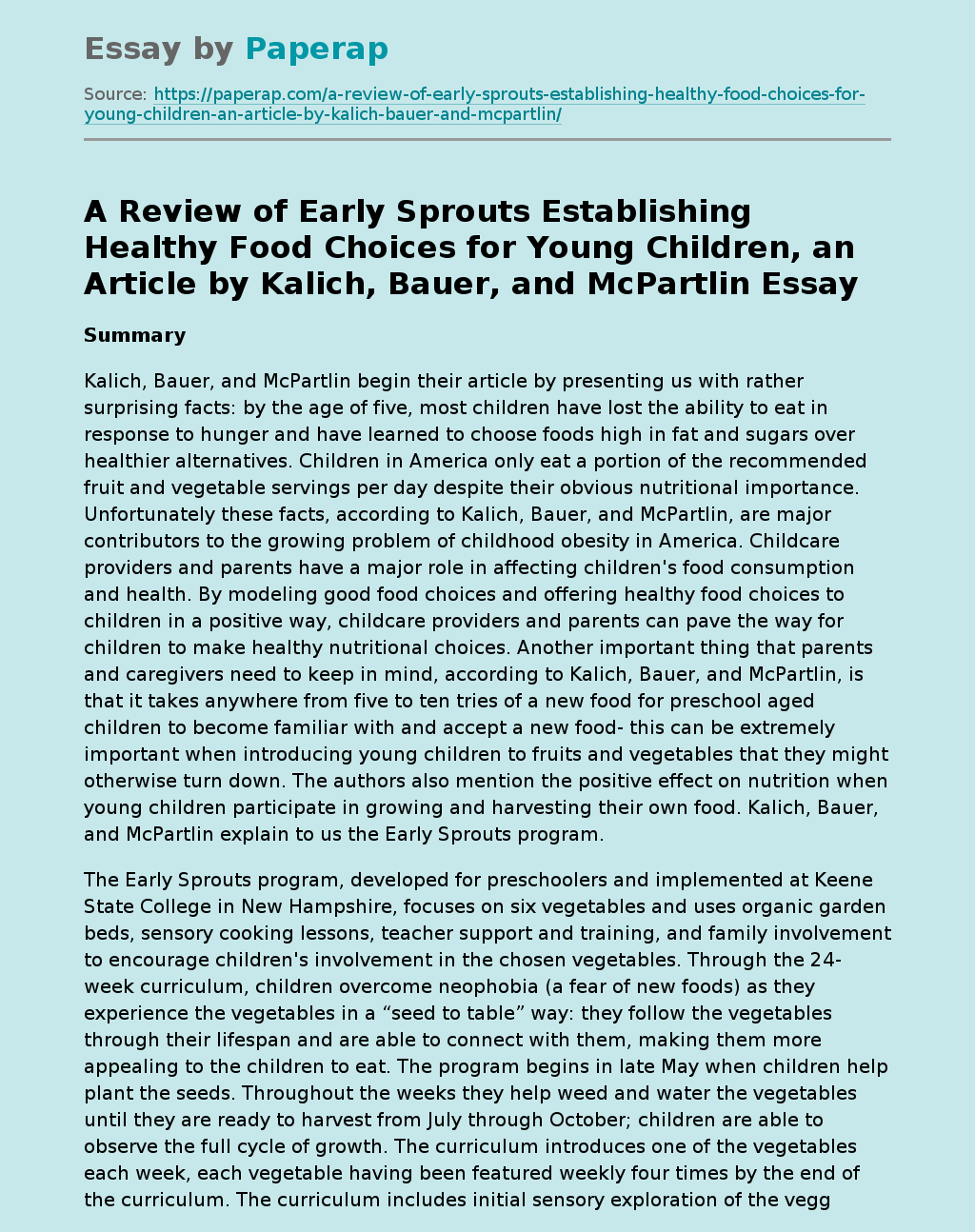Early Sprouts Review
Summary
Kalich, Bauer, and McPartlin begin their article by presenting us with rather surprising facts: by the age of five, most children have lost the ability to eat in response to hunger and have learned to choose foods high in fat and sugars over healthier alternatives. Children in America only eat a portion of the recommended fruit and vegetable servings per day despite their obvious nutritional importance. Unfortunately these facts, according to Kalich, Bauer, and McPartlin, are major contributors to the growing problem of childhood obesity in America.
Childcare providers and parents have a major role in affecting children’s food consumption and health. By modeling good food choices and offering healthy food choices to children in a positive way, childcare providers and parents can pave the way for children to make healthy nutritional choices. Another important thing that parents and caregivers need to keep in mind, according to Kalich, Bauer, and McPartlin, is that it takes anywhere from five to ten tries of a new food for preschool aged children to become familiar with and accept a new food- this can be extremely important when introducing young children to fruits and vegetables that they might otherwise turn down.
The authors also mention the positive effect on nutrition when young children participate in growing and harvesting their own food. Kalich, Bauer, and McPartlin explain to us the Early Sprouts program.
The Early Sprouts program, developed for preschoolers and implemented at Keene State College in New Hampshire, focuses on six vegetables and uses organic garden beds, sensory cooking lessons, teacher support and training, and family involvement to encourage children’s involvement in the chosen vegetables.
Through the 24-week curriculum, children overcome neophobia (a fear of new foods) as they experience the vegetables in a “seed to table” way: they follow the vegetables through their lifespan and are able to connect with them, making them more appealing to the children to eat. The program begins in late May when children help plant the seeds. Throughout the weeks they help weed and water the vegetables until they are ready to harvest from July through October; children are able to observe the full cycle of growth. The curriculum introduces one of the vegetables each week, each vegetable having been featured weekly four times by the end of the curriculum. The curriculum includes initial sensory exploration of the veggie, an Early Sprouts cooking activity, and a Family Recipe Kit for children to take home where the food experience can be reinforced.
Kalich, Bauer, and McPartlin go on to more deeply explain each component of the Early Sprouts program. The sensory exploration portion of the program allows children to safely explore the vegetables with their five senses, leading them to be more comfortable with the vegetables. The cooking experience connects the program to other curriculum areas (science, math, and literacy for example). The family involvement portion, which includes the recipe kits and a family newsletter, encourages healthy choices outside of the childcare center. The teacher and staff support portion ensures that the Early Sprouts program continues to be successful. An evaluation of the Early Sprouts program shows that at the end of the curriculum period, children are more willing to try new foods and are more open to eating the six vegetables studied in their early childhood classroom.
Questions
The article sparked a couple of questions in my mind: What route do you take if a child is still resistant to trying new foods, even after going through the Early Sprouts program? How can the program be adapted for young toddlers and twos, who might not yet grasp the seed-to-table process?
New Information
The entire concept of growing a garden in the curriculum was new to me. I know that people use little growth projects, such as maintaining classroom flowers or sprouting a bean in a cup, but I had not thought of growing a vegetable garden with the children and taking them through the entire seed-to-table process. I also learned that a fear of new foods is an actual phobia with a name!
Use Information
I would definitely incorporate a vegetable garden into my classroom! I love the idea of giving the children a connection with the food so that they are more inclined to try it. If the center lacked the space or resources for me to do an outdoor garden, an indoor box vegetable garden could easily be arranged. I would use the same basic program outline as Early Sprouts, especially with the family involvement kit. Getting families together and cooking with what their children have grown at school is a great idea for involvement and curriculum reinforcement.
Early Sprouts Review. (2021, Dec 15). Retrieved from https://paperap.com/a-review-of-early-sprouts-establishing-healthy-food-choices-for-young-children-an-article-by-kalich-bauer-and-mcpartlin/

